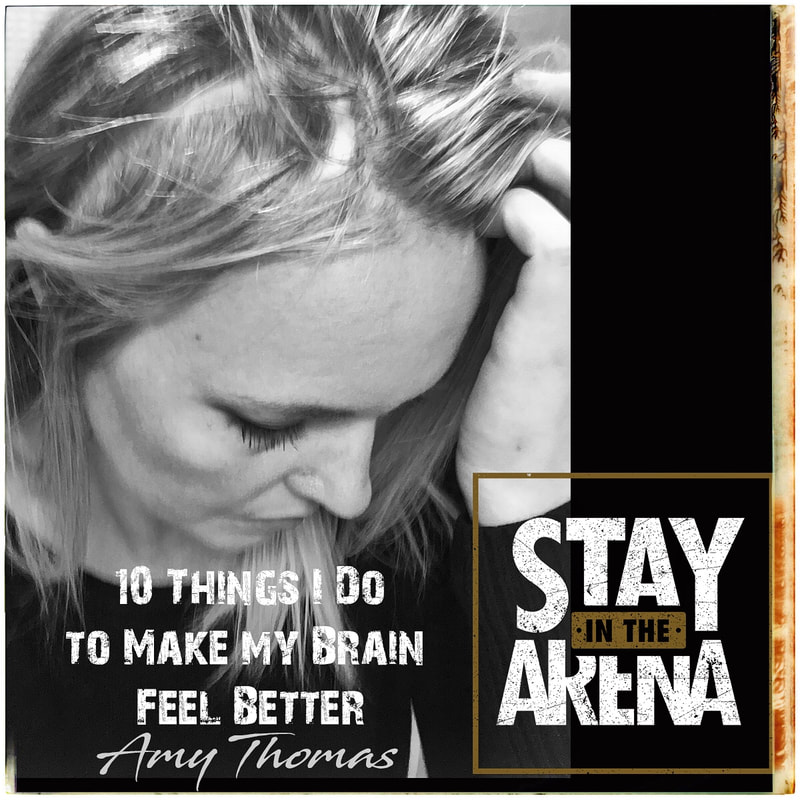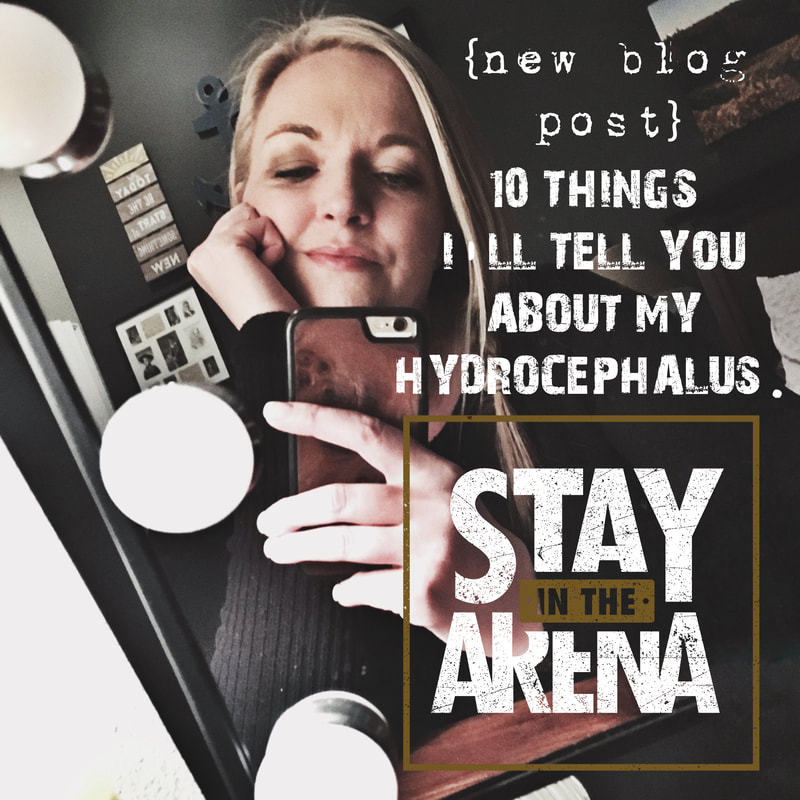 Hydrocephalus sucks. It really does. It’s like sailing on the uncertain and ever-changing sea of spinal fluid, hanging on for dear life. There’s a John Mayer song called “Emoji of a Wave” and a close friend of mine used to make me laugh by quoting the lyrics to this song to me. Whenever the proverbial skies would darken and the storms of shunt surgery were inevitable, he’d say to me, “Oh, Honey, it’s just a wave.” We ride these waves… these waves of water on the brain. But I’m always looking for ways to improve. I feel like we all are. In my last blog post, I shared 10 random things about my journey with hydrocephalus. Today, I want to share 10 things that I do regularly that I believe make a difference in my ability to fight this condition. If you are battling hydrocephalus as well - or if you know someone who is – I hope that this post is helpful in some way. I know that I have always found comfort in learning what has helped other people. Many of these concepts are also shared in more detail on my website. While I can’t give medical advice because I’m not a doctor, I hope that these topics can give you some ideas to ask your own doctors and therapists about. Lastly, thank you to everyone who plays a role in keeping me healthy and safe. It takes a village, and I’m fortunate to have some brilliant and caring people in my corner. We’re building this road, and I am committed to walking it with relentless determination and reckless joy. May we never stop learning. #we. Hydrate (and eat) regularly. Hydrocephalus is defined as an abnormal accumulation of cerebral spinal fluid (CSF) in the ventricles of the brain. The human body makes about a soda can of new spinal fluid every day. Everything we put in our bodies either supports the body in making fluid or dehydrates the fluids in the body. Although it may be a very simple way of looking at this, I generally try to decide whether I feel like my symptoms are from under-draining (high pressure) or over-draining (low pressure) – then manipulate the fluid my body is making or absorbing by eating and/drinking accordingly. The body is a complicated organism, but I do find that sometimes I can help myself out just by staying generally consistent with my nutrition. Then I can adjust that baseline as needed. Ask your neurosurgeon or neurologist what foods and beverages will positively or negatively affect the levels of CSF in the brain. As a side note, I have found an anti-inflammatory version of the Paleo diet (no grains, legumes, or dairy) with an emphasis on high quality meats, vegetables, and fat has been very helpful in my quick physical recoveries from surgery. I am not always strict with this protocol, but usually try to follow it closely for a few weeks after each surgery. Exercise consistently. I strength train with a coach five days a week. Staying active and as physically strong as possible is one of the most significant factors in my success over the past 5-6 years. In addition to staying ready for any issues that may arise with my shunt, I have found that even if the actual act of lifting weights is uncomfortable, I generally have lower pain levels if I am lifting regularly. I get a lot of questions from people in the hydrocephalus community regarding how physically active I am – and the most common questions are about what to do if exercise makes your pain worse. Again - I’m not a doctor. But what I have found is that generally speaking, physical effort is going to help with high pressure (under-draining) symptoms – which is the most common type of pain for me to have. Low pressure pain, from over-draining of a shunt, is more than likely going to be made worse by any sort of exertion. These things are important to track, and to tell your neurosurgeon about. Aron, my strength coach, is usually one of the first people to notice subtle changes in my functioning… because he is tracking what I normally am able to do and can note even small changes or trends in my training. Then we use that information to help my neuro team when they are trying to figure out if my shunt is occluding again. Lay down when I need to. Just like the exercise thing, it’s important to understand how body position will affect your shunt. If you are over-draining, and activity is making things worse, the only thing that may help is to lie on your back, to slow the rate of the shunt. Sometimes, if just lying down doesn’t help, I lay on my back with an ice pack at the base of my skull, and/or elevate my legs. Medicate to the lowest common denominator. I have a strict policy not to answer questions or share information about medications – past or current. This is an area that I strongly believe should only be discussed by a patient with their medical team. But I will tell you that in general, I try to take the least possible amount of medication that will reduce a reasonable amount of my pain and symptoms. I call this “medicating to the lowest common denominator”. For me personally, it’s important to put as little medication as possible into my body on a regular basis. I do have a pain management doctor who I work closely with to manage my care. Keep a fairly structured schedule. I keep as close to the same sleep schedule as possible, seven days a week. I also exercise on the same days and keep my work schedule consistent. All of these factors make it easier for me mentally and physically – and again, really help with comparing with a baseline of energy and function when I start to malfunction. Understand how trauma and damage to my nervous system play a part in my pain and symptoms… and focus on soothing those factors. A few years ago, I started to study the nervous system and how the brain reacts to trauma. I found that a lot of my symptoms are consistent with the physical struggles that affect traumatic brain injury (TBI) and post-traumatic stress disorder (PTSD) patients. This has helped me to understand and accept many of the issues that I experience – especially right after surgery. As it does with every patient, it has evolved over time. Some of my symptoms are very predictable now, but others are new and can be scary without that general understanding of what my brain and body are trying to process. My study of this subject has led to work with some brilliant rehabilitation experts, and I am always trying to find new ways to soothe my nervous system. Some of the things are simple, like swinging on a swing set. Others are more involved, like working with a therapist who specializes in a modality called Trauma Release Exercise (TRE). Stay spiritually engaged. My relationship with God is a big part of my life. It keeps me grounded in what I believe to be true. Above all things, I have great peace in my belief that God created me with a purpose. There may not be a reason for my pain, but there can be a purpose. I’m willing to stay in the arena and see how that plays out. That’s my choice, and I actively choose it every day. Practice mental training. I have written extensively on my blog about mental skills training, and I practice certain aspects of it every day. Meditation, affirmation, and relaxation techniques can all play a part in how I feel on a physical basis – because it affects how I experience pain. It doesn’t mean that the pain isn’t there, but it helps me get through it by controlling my response. See a counselor when I need extra support. I have seen a counselor off and on for many years and have also done therapy with a pain management psychologist. All of the work we have done has given me a basis of strength on which to draw when things get hard. I am thankful for the support I have received from my counselors. I always encourage patients, parents, and children affected by hydrocephalus to pay special attention to their emotional and mental health, as it is so crucially important and makes a difference in your physical health as well! Listen to lots of music. Music is an amazing healing tool, that has been scientifically proven to affect the brain in such unique ways, that it isn’t even fully understood yet. But listening to music as a form of meditation has been a part of my daily routines for several years now. I rely heavily on a constant stream of specifically curated playlists of music to get me through difficult spikes in pain, and to generally soothe my soul. Music truly heals.
2 Comments
 Here are 10 things I’ll tell you about my life with hydrocephalus (in no particular order). 1. It hurts. The most common questions I get via my blog or social media relate to what my headache pain is like, and how I treat it. I have a strict policy that I don’t share specifics regarding medications, etc. but I will tell you that I do have chronic daily headaches, and I manage them with a combination of medication, lifestyle, and therapy. Mental training and meditation are also a part of my daily life, and through these I control my reaction and experience with pain. 2. I believe that the trauma my brain (and body) goes through due to hydrocephalus can be healed-- if I am willing to put in the work. When I was re-shunted in 2012, I made it a personal challenge to learn as much as I could about neuroscience and the brain. I devoured everything I could learn about hydrocephalus and the treatment options that are available. I also researched the healing processes of the brain and body. I currently do strength training (weight lifting) five days a week, and work methodically towards rehabilitation after each surgery. Music therapy has helped me a lot. In addition I focus on my nutrition, hydration, and rest to assist in my healing. 3. I love my neurosurgeon. I travel 3 hours for the surgeon that I have seen for over ten years. He is in a small market (Bend, Oregon) but the drive is well worth it. The most important things to me are that I communicate well with him, he knows my case, and I know he believes in me. Even when I have a hard time healing from brain surgery, and he knows I will give 100% effort, all the time. There is nothing more crucial than having a good working relationship with the person who is making game-time decisions on your behalf. 4. My face tingles. The facial nerve that runs through my right cheek tingles intensely, is painful, and makes my eye droop sometimes when my shunt is acting up. This is not necessarily a classic symptom of hydrocephalus. But it’s a symptom that I have – a result of having the right side of my head cut open 20+ times. It’s just damaged. So… sometimes things happen that lead to other things happening. It’s just part of the deal. I try hard to take care of all those little things that come along with the overall package – because taking care of the little things makes dealing with the big things a heck of a lot easier. 5. I have trouble with balance. Yep. It’s almost comical. My balance is so bad sometimes… I have fallen in the grocery store, on construction jobsites, and in the gym – all in the past 6 months! So, I work really hard at staying safe, and knowing the environments in which my brain gets a little shaky. Personally, I have a harder time with balance when my nervous system gets overwhelmed – so I try to stay out of situations where there is a lot of confusion… big crowds milling around, or a lot of flashing lights and colors. Those are things that bother me personally – you may have totally different triggers. But just know that if you struggle to stay on your feet, you are not alone! 6. It takes about 3 weeks after brain surgery for me to start to feel like myself again, and it takes about 6 weeks for me to fully heal. I have a pretty consistent response to surgery, and I am thankful for the predictability of these patterns. I find comfort in knowing that the horrible parts won’t last forever, and I am highly motivated to push for the good days. 7. Sleep is a battle. Lying down makes my programmable shunt’s flow slow down, and I get really bad pressure headaches at night. I also have a lot of nerve pain now, which flares up at night when I lay down. I have never been able to get into a deep sleep if I’m propped up, so I just try to sleep the best I can. When I wake up in the middle of the night, I have to get up and walk around a little bit. Then I listen to a sermon from one of my favorite pastors, an Audiobook, or a sleep meditation until I fall asleep again. 8. My hair is falling out. I was blessed with really thick long blonde hair – which completely covers my incision site. But my scalp has taken a beating on the right side, and recently I have had hair falling out in big chunks, which is really alarming. I found out that this is a common trauma response, especially after a lot of anesthesia… and I had 3 surgeries in 5 months in 2018. So I’m taking all the steps to protect my hair as best possible, but also to soothe my nervous system. It’s slowly getting better! 9. Hydrocephalus affects my relationships with other people. This might seem obvious, but it’s worth saying out loud (or on paper… or in this blog post.) Sometimes hydrocephalus has had a negative effect on my relationships, but on the flip side… there are people in my life that I never may have known if it wasn’t for hydrocephalus. There are lots of things that can be said on this topic… In fact, it was one of the things I spoke about at the 2018 HA Conference – but the bottom line is that the people who are meant to be in my life will be there. Others, who are meant to be there for just a season, will come and go. Ultimately, this is my path to walk… and for those who make the choice to stand in battle with me today, I am forever thankful. 10. I am grateful for the journey. When I was diagnosed with hydrocephalus at age 17, I had no idea how much it would change my life going forward. Recently I have spent a good deal of time studying ancient stoic philosophy. Learning about the stoic mentality has given me a better understanding of how people in history have overcome enormous obstacles. I have come to accept that the exact thing that has brought me the most pain and challenge in my life has also been the thing that has brought me the most purpose and motivation. I believe that hydrocephalus has made me a stronger person, and has taught me patience, endurance, and empathy for others who are in the same boat. I have committed myself to using the journey that I am on to try to help other people, by sharing my story and supporting them in their own. For these things, and for the incredible souls that are on this life path with me, I have relentless love. Over the years, I have shared a lot of things about my life with hydrocephalus, but I still feel like there are so many people out there who are struggling with loneliness in this diagnosis. If you are one of those incredible humans… if you have hydrocephalus and feel alone, or if you have a child who has been diagnosed with hydro and you are desperately looking for information, inspiration, and comfort… I’m here to tell you that you are not alone. We may be facing a giant mountain of uncertainty, but we will climb it together. Thank you for reading my words. And thank you for walking beside me. Here’s to our relentless pursuit, Amy |
AuthorMy name is Amy but friends and family call me Am. I am a lover of dogs, good whiskey, and strength training. I'm a brain surgery survivor (x31), a fiddle player, a construction designer, and a boxing enthusiast. I have six real siblings, and five fake brothers. I love deeply, and consider my close friends to be family. Archives
February 2022
Categories
All
|


 RSS Feed
RSS Feed